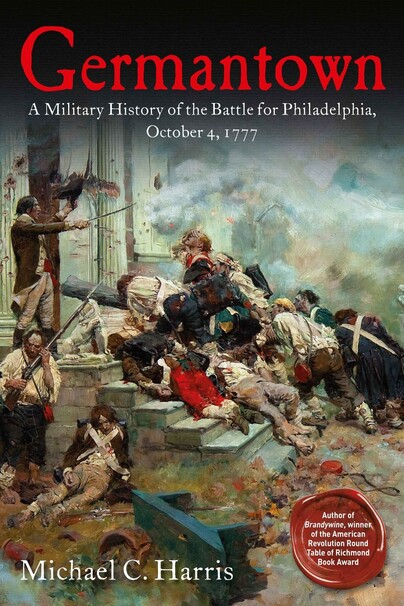

Pages: 528
ISBN: 9781611215199
Pub Date: November 2020
Imprint: Savas Beatie
Illustrations: 18 maps, 28 images
Price:
£28.99
Usually available in 6-8 weeks
Pages: 528
ISBN: 9781611216929
Pub Date: September 2024
Imprint: Savas Beatie
Illustrations: 48 images, 27 maps
Price:
£21.99
In stock
Description:
Today, Germantown is a busy neighborhood in Philadelphia. On October 4, 1777, it was a small village on the outskirts of the colonial capital whose surrounding fields and streets witnessed one of the largest battles of the American Revolution. The bloody battle represented George Washington’s attempt to recapture Philadelphia, but has long been overshadowed by better-known events like Brandywine, Saratoga, and Valley Forge. Award-winning author Michael C. Harris’s impressive Germantown: A Military History of the Battle for the Control of Philadelphia, October 4, 1777, elevates this important action from obscurity in the first full-length study of this pivotal engagement.General Sir William Howe launched his campaign to capture Philadelphia in late July 1777, with an army of 16,500 British and Hessian soldiers aboard a 265-ship armada sailing from New York. Six difficult weeks later, Howe’s expedition landed near Elkton, Maryland, and moved north into Pennsylvania. Washington’s rebel army did all it could to harass Howe and fought and lost a major battle at Brandywine on September 11. Philadelphia fell to the British.On October 4, obscured by darkness and a heavy morning fog, Washington launched a surprise attack on the British garrison at Germantown. His early attack found initial success and drove the British legions before him. The recapture of the colonial capital seemed within Washington’s grasp until poor decisions by the American high command brought about a reversal of fortune and a clear British victory. Like Brandywine, however, the bloody fight at Germantown proved that Continental soldiers could stand toe-to-toe with British Regulars. The Battle of Germantown began a protected quasi-siege of the British garrison in Germantown prior to the travails soon to come that winter at Valley Forge.Harris’s Germantown is the first complete study to merge the strategic, political, and tactical history of this complex operation and important set-piece battle into a single compelling account. Following up on his award-winning Brandywine, Harris’s sweeping prose relies almost exclusively on original archival research and a deep personal knowledge of the terrain. Complete with original maps, numerous illustrations, and modern photos, and told largely through the words of those who fought there, Germantown: A Military History of the Battle for the Control of Philadelphia, October 4, 1777 is sure to please the most discriminating reader and assume its place as one of the finest military studies of its kind.
Today, Germantown is a busy neighborhood in Philadelphia. On October 4, 1777, it was a small village on the outskirts of the colonial capital that hosted one of the largest battles of the American Revolution. George Washington’s attempt to recapture Philadelphia has been misunderstood and long overshadowed by the battles of Brandywine, Saratoga, and the difficult winter that followed at Valley Forge. Michael C. Harris, the award-winning author of Brandywine: A Military History of the Battle that Lost Philadelphia but Saved America, September 11, 1777 (2014), has produced the first full-length book on the Battle of Germantown, lifting the pivotal engagement out of its undeserved obscurity.General Sir William Howe launched his campaign to capture Philadelphia in late July 1777. His army sailed aboard a 265-ship armada from New York and six difficult weeks later landed near Elkton, Maryland, moved north into Pennsylvania, and defeated Washington’s American army at Brandywine on September 11. Philadelphia fell soon thereafter.When he spotted an opportunity to defeat part of Howe’s army, Washington devised and launched a complex four-column attack, marching his men most of the night to strike the British early on the morning of October 4. Obscured by ground fog, the attack caught the British garrison at Germantown by surprise. With the enemy collapsing and his reserves yet to fire a shot, Philadelphia seemed within Washington’s grasp—until a series of poor decisions by the American high command around the Chew House brought about a stunning reversal of fortune that swept the Americans from the field. Although a tactical defeat, Germantown proved Continental soldiers could stand toe-to-toe with British and Hessian Regulars.Germantown is the first complete study to merge the strategic, tactical, political, and naval history of this complex regional operation and set-piece battle into a single compelling account. Harris’s sweeping prose, which begins where his award-winning Brandywine left off, relies extensively on original archival research and (to the extent possible today) personal knowledge of the terrain. Germantown is no mere retelling, but a major reinterpretation of the battle, troop movements, and decision-making (including the fascinating chess match for control of the forts along the Schuylkill River) that nearly drove the British out of Philadelphia. Twenty-seven original maps, together with illustrations and modern photos, extensive explanatory footnotes, appendices, and an order of battle support the text and provide contextual understanding of the movement of the armies and the strategic and tactical implications of this grand matching of wills.Michael Harris’s Germantown, now in paperback, sets the standard for Revolutionary War battle studies and will please the most discriminating reader.
